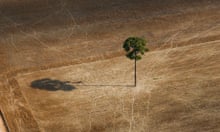Why do we care about nature, and can we actually quantify what the benefits are? This is what the UN's The Economics of Ecosystems and Biodiversity (Teeb) project is all about, and the answer is remarkable. The natural world – biodiversity – provides us with food, materials and energy. We eat animals and plants; insects pollinate many of the foods we consume; microbes in the soil provide the nutrients the plants to grow; vegetation and soil biodiversity reduce flooding and release clean drinking water; vegetation soaks up a substantial proportion of the climate warming carbon dioxide gasses that we emit. The list goes on and on. Urban and rural citizens alike rely on these natural products and benefits.
The real cost of damaging nature, it turns out, is at least 10 times greater than the cost of maintaining the ecosystem as it is so that we can reap the associated benefits. To take an example close to the University of York where I work, the costs of flood defence construction and flood-related insurance claims in the Vale of York hugely outweigh the agricultural benefits of drainage ditches and overgrazing in the River Ouse catchment. Rather than treating nature as a pleasant luxury, Teeb argues that we should integrate the real costs and benefits within our decision-making. It should not be the preserve solely of environment and conservation ministries, but it should be at the core of the activities of finance departments.
Teeb argues that we should get rid of subsidies that are environmentally damaging and reward beneficial activities that maintain natural ecosystems. This might be by including the costs of damage within the purchase price of products to encourage us to buy the least damaging items, and potentially by paying land owners and countries directly to maintain natural ecosystems. Farmers in the Ouse catchment have recently received payments for blocking their drainage ditches; and the perverse subsidies that rewarded farmers by the animal – resulting in over-grazing, trampling and erosion – have been removed. It can be done. Achieving this at a global scale is far more difficult.
If you keep microscopic predators and prey in a small bottle, the predator usually becomes too common, eats most or all of the prey, and then dies out itself. In Pilanesberg Game Reserve, a fenced 572 km2 game reserve in South Africa, predator numbers had to be reduced to stop antelope numbers from collapsing. A larger bottle.
The planet is our bottle: 7 billion people and counting, 2 billion more by the middle of this century, with the level of consumption per person increasing just as fast. Greening the world's economies and social systems is essential is we are to avoid a similar collapse. Let us hope that the Teeb conclusions and reports take us a step in that direction.
Chris Thomas is professor of Conservation Biology, Department of Biology, University of York.


